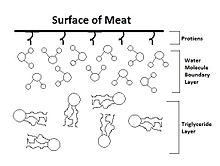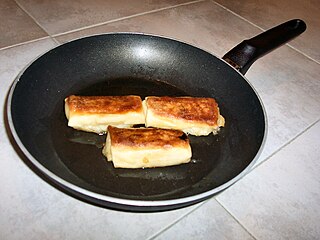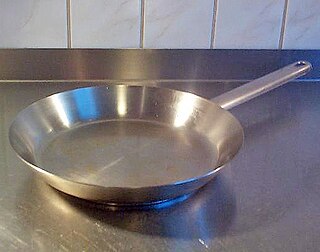Materials in cooking
The interactions between food and pan are very dependent on the material that the pan is made of. Whether or not the pan is hydrophilic or hydrophobic, the heat conductivity and capacity, surface roughness, and more all determine how the food is cooked.
Stainless steel

Stainless steel is considered stainless because it has at least 11% chromium by mass. Chromium is a relatively inert metal and does not rust or react as easily as plain carbon steel. This is what makes it an exceptional material for cooking. It is also fairly inexpensive, but does not have a very high thermal conductivity. From a surface standpoint, this is because of the thin layer of chromium oxide that is formed on the surface. This thin layer protects the metal from rusting or corroding. While it is protective, the oxide layer is not very conductive, which makes cooking food less efficient than it could be. For most cooking applications, high thermal conductivity is desirable to create an evenly heated surface on which to cook. In this way, stainless steel is usually not considered high-grade cookware.
In terms of surface interactions, chromium oxide is polar. The oxygen atoms on the surface have a permanent dipole moment, and are therefore hydrophilic. This means that water will wet it, but oils or other lipids will not.
Cast iron

Cast-iron cookware is seasoned with oil. The surface of the cast iron is not very smooth; it has pits and peaks that are not conducive to cooking. Typically, the cookware is seasoned with oil. This process leaves a thin coat of oil in the pits and on top of the peaks on the surface of the pan. This thin coat actually polymerizes, making it durable and lasting. It also prevents the cast iron from rusting, which it is prone to do. The oil that is used in a seasoned pan combines with any liquid that is used in the cooking process and creates a good contact between pan and food. Even though the cast iron itself is a poor heat conductor, the oil makes the pan effective when it is at a high temperature.
The other effect that the seasoning oil has is to make the surface of a cast-iron pan hydrophobic. This makes the pan non-stick during cooking, since the food will combine with the oil and not the pan. It also makes the pan easier to clean, but eventually the polymerized oil layer which seasons it comes off and it needs to be re-seasoned. [1]
Ceramic
Ceramic cookware (as in pans, not baking dishes) is not made of a solid ceramic, but rather is a metal pan, typically aluminum, with a nano-particle ceramic coating. This makes the surface rough on a small-scale and causes solutions to bead up more and not stick to the surface.
The downside is that the increased surface area means less surface contact with the food that is to be cooked and therefore has less heat transfer. Unfortunately, since the surface is fine, it can be scratched off over time, and the benefit from having it in the first place is lost. [2]
Polytetrafluoroethylene (Teflon)
Polytetrafluoroethylene (commonly called by its DuPont brand name, Teflon) is a polymer that is used as a coating for non-stick cookware. The polymer is a polyethylene chain with fluorine atoms replacing the hydrogen atoms. The strength of the carbon-fluorine bonds makes it nonreactive to most things. Furthermore fluorine bonded to carbon tends to not form hydrogen bonds, [3] and this along with the overall relatively weak London dispersion forces present result in Teflon poorly sticking to other substances. Teflon has the third lowest coefficient of friction of any known solid.[ citation needed ] It is also relatively cheap and very common.
The downsides of Teflon include the fact that it can be scratched off and get into food during the cooking process. Another problem is that Teflon begins to break down at around 350 °C and can give off poisonous fluorocarbon gasses. The final problem is that the bonding of Teflon to the pan uses a surfactant called perfluorooctanoic acid (PFOA), which can also break down at high temperatures and poison food. Modern pans no longer use PFOA as it's banned in the European Union.
Silicone
Silicone is a heat-resistant rubber that is inert and non-toxic. They are polymers that typically have a silicon–oxygen backbone with methyl ligands. The fairly inert methyl groups are not very reactive, giving the silicone a fairly low coefficient of friction. Just like Teflon, this makes them non-stick and easy to clean. They are also resistant to very high temperatures due to the strong bonds between all of the atoms. This means that they can be baked or used around hot oils.
Silicone has a very specific use as cookware, since it is not rigid. Most silicon used in cooking is in the form of spatulas or molds, and as such serve a different purpose than the previously discussed materials.




































